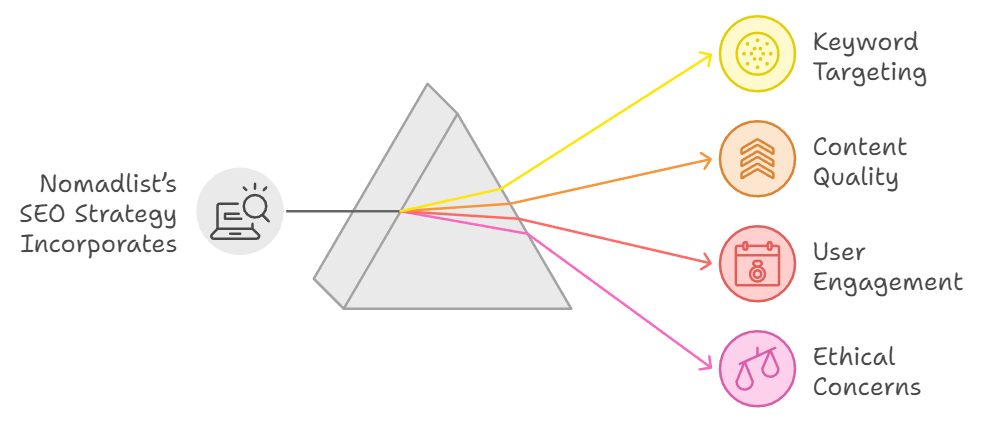Listen to this story
Overview of Nomadlist
Nomad List is a comprehensive online resource designed to empower remote workers and location-independent startups. It curates data on various factors critical to digital nomads, including cost of living, internet connectivity, climate, and other relevant metrics.
This information empowers users to make informed decisions about the most suitable locations to live and work based on their individual needs and preferences.
A brief overview of Nomadlist’s programmatic SEO strategy
Nomadlist leverages programmatic SEO to automatically generate SEO-friendly pages for a vast number of destinations. Here’s a breakdown:
- Data-Driven Content: Their core information like internet speed, cost of living, and descriptions are likely populated from their internal database and applied to each destination page.
- Scalability: This approach allows them to efficiently create content for a large number of cities without manual effort for each page.
- Targeting: Programmatic SEO helps them target long-tail keywords related to specific locations and digital nomad needs (e.g. “fast internet cafe Chiang Mai”).
Overall, Nomadlist’s programmatic SEO strategy allows them to effectively reach a wider audience of digital nomads searching for their ideal remote work location.
Segregation of traffic numbers behind Nomadlist’s programmatic SEO strategy
- Direct: 41.59% (166.8K)
- Organic Search: 35.38% (141.9K)
From a programmatic SEO perspective, a high percentage of both direct and organic traffic indicates success for Nomad List:
- Strong Brand Recognition (Direct Traffic): A significant portion of direct traffic (41.59%) suggests a strong brand among digital nomads. People familiar with Nomad List bypass search engines and head straight to the source, indicating brand loyalty or a well-established reputation.
- Effective SEO Strategy (Organic Traffic): The high organic traffic (35.38%) demonstrates the effectiveness of their programmatic SEO approach. They’re ranking well for relevant keywords, attracting new users actively searching for information about remote work locations.
A healthy balance between direct and organic traffic is ideal. Direct traffic signifies brand awareness, while organic traffic shows your SEO efforts are attracting new users. Nomad List’s traffic breakdown suggests they’ve achieved this balance, indicating a strong overall web presence.
SOURCE: Semrush
Detailed Nomadlist programmatic SEO strategy
43.2K+ monthly organic traffic
33K + pages indexed on Google
cost of living in {place}
- Cost of Living in Buenos Aires
- Cost of Living in Lisbon
best places to live in {location}
- Best Places to Live in Africa
- Best Places to Live in North America
A Deep Dive into the Structure of Nomadlist Pages/Section
Let’s delve into the specifics of Nomadlist’s page structure and explore how they leverage programmatic SEO to achieve their goals. We can analyze an example page to illustrate these techniques in action.
Cost of Living Pages
Nomadlist targets the cost of living for various locations ({place} can be any city). This information serves an informational purpose for users.
Programmatically generated pages under the “cost of living” section function similarly to landing pages, attracting users interested in that specific aspect of a city’s suitability for remote work.
To illustrate this further, let’s explore some example city pages and analyze the organic traffic they generate each month. This will demonstrate the effectiveness of programmatic SEO in driving traffic to these cost-of-living focused sections.
| Example page | Monthly organic traffic |
| Cost of Living in Lisbon | 83 |
| Cost of Living in Buenos Aires | 84 |
| Cost of Living in Mexico City | 127 |
Data Points
Leveraging programmatic SEO, Nomadlist populates these pages with various data points, such as:
- A title of the page
- Call-to-action buttons
- An image as of the location as the hero section background
- Cost of living data for different categories
- Hotel, food, and other items cost data
Best Places to Live Pages
Within this section, Nomadlist focuses on providing informative content about the best places to live in various locations. These programmatically generated pages under “best places to live” can be categorized as landing pages.
Essentially, they act as entry points for users who are researching potential remote work destinations.
Let’s now explore some specific examples of these pages and analyze the estimated organic traffic they receive each month. This will provide insights into the effectiveness of their programmatic SEO strategy for these landing pages.
| Example page | Monthly organic traffic |
| Best Places to Live in North America | 112 |
| Best Places to Live in Africa | 116 |
| Best Places to Live in Europe | 198 |
Data Points
Leveraging programmatic SEO, Nomadlist populates its city pages with a range of data points, such as…
- A title of the topic
- A detailed description of the place
- Photos of all listed places
- Names, internet speed, temperature, and other information about all places
- Cost of living of all listed places
Expanding Nomadlist’s SEO Strategy: Analysis and Insights
Strategic Elements of Success
Nomadlist’s programmatic SEO leverages precise keyword targeting and structured data to cater to specific user intents. The use of long-tail keywords related to digital nomad lifestyles, such as “best cities for digital nomads” or “affordable coworking spaces,” alongside a data-driven approach for content creation, significantly boosts its organic search visibility.
Programmatic SEO for Diverse Business Landscapes
While programmatic SEO offers scalability and efficiency, its suitability varies by industry, audience, and resources. For example, e-commerce sites can benefit from automated page generation for extensive inventories, whereas service-oriented businesses might prioritize deeper content customization to enhance user engagement.
The Role of Data in SEO Optimization
Data analysis in programmatic SEO at Nomadlist informs content creation and keyword optimization, ensuring content relevance and improving search rankings. By analyzing user behavior and search trends, Nomadlist effectively aligns its content with what potential visitors are actively seeking.
Ethical Considerations in Programmatic SEO
While programmatic SEO can significantly enhance a site’s reach, it also raises concerns about content quality and user experience. Ensuring high-quality, valuable content is crucial to maintain trust and satisfy user intent without compromising on the integrity of the search ecosystem.
Comparative Analysis with Traditional SEO
Compared to traditional SEO, programmatic SEO like Nomadlist’s offers the unique advantage of handling vast arrays of data and content needs efficiently. However, it requires rigorous management to avoid issues like duplicate content, which can detract from user experience and site credibility.
Build a programmatic SEO Strategy with uG
And that’s how Nomadlist leverages programmatic SEO to capture over 43.2K+ monthly organic visits. Their success highlights the power of this approach for data-driven websites targeting specific niches.
If you’re looking to emulate Nomadlist’s results and unlock the potential of programmatic SEO for your own business, partnering with experienced SEO specialists like upGrowth is a strategic move.
upGrowth’s team possesses the in-depth knowledge and technical expertise to craft a programmatic SEO strategy tailored to your unique goals and target audience, propelling your website’s organic traffic and overall online visibility.
Watch Now: How Nomadlist Programmatic SEO Delivers 43.2K+Monthly Organic Traffic
Glossary of Key Terms
- Programmatic SEO: An SEO strategy that utilizes automation and data to generate and optimize large volumes of web pages tailored to specific keywords and user searches.
- Organic Traffic: Website traffic that comes from unpaid search engine results.
- Direct Traffic: Website traffic that comes from users directly entering the website URL or clicking a bookmark.
- Long-tail Keywords: Longer and more specific keyword phrases that target niche user searches.
- Landing Page: A standalone web page designed to capture leads or drive conversions for a specific marketing campaign or offer.
- Data-Driven Content: Content that is created and informed by data analysis, ensuring relevance and targeting specific user needs.
- Scalability: The ability of a system or process to handle increasing workloads efficiently.
- Brand Recognition: The extent to which customers are familiar with and recall a particular brand.
- Digital Nomad: A person who works remotely while travelling and living in different locations.
- SEO (Search Engine Optimization): The process of optimizing a website to rank higher in organic search results.
Segregation of traffic numbers behind Nomadlist’s programmatic SEO strategy
- Direct: 41.59% (166.8K)
- Organic Search: 35.38% (141.9K)
From a programmatic SEO perspective, a high percentage of both direct and organic traffic indicates success for Nomad List:
- Strong Brand Recognition (Direct Traffic): A significant portion of direct traffic (41.59%) suggests a strong brand among digital nomads. People familiar with Nomad List bypass search engines and head straight to the source, indicating brand loyalty or a well-established reputation.
- Effective SEO Strategy (Organic Traffic): The high organic traffic (35.38%) demonstrates the effectiveness of their programmatic SEO approach. They’re ranking well for relevant keywords, attracting new users actively searching for information about remote work locations.
A healthy balance between direct and organic traffic is ideal. Direct traffic signifies brand awareness, while organic traffic shows your SEO efforts are attracting new users. Nomad List’s traffic breakdown suggests they’ve achieved this balance, indicating a strong overall web presence.
SOURCE: Semrush
Detailed Nomadlist programmatic SEO strategy
43.2K+ monthly organic traffic
33K + pages indexed on Google
cost of living in {place}
- Cost of Living in Buenos Aires
- Cost of Living in Lisbon
best places to live in {location}
- Best Places to Live in Africa
- Best Places to Live in North America
A Deep Dive into the Structure of Nomadlist Pages/Section
Let’s delve into the specifics of Nomadlist’s page structure and explore how they leverage programmatic SEO to achieve their goals. We can analyze an example page to illustrate these techniques in action.
Cost of Living Pages
Nomadlist targets the cost of living for various locations ({place} can be any city). This information serves an informational purpose for users.
Programmatically generated pages under the “cost of living” section function similarly to landing pages, attracting users interested in that specific aspect of a city’s suitability for remote work.
To illustrate this further, let’s explore some example city pages and analyze the organic traffic they generate each month. This will demonstrate the effectiveness of programmatic SEO in driving traffic to these cost-of-living focused sections.
| Example page | Monthly organic traffic |
| Cost of Living in Lisbon | 83 |
| Cost of Living in Buenos Aires | 84 |
| Cost of Living in Mexico City | 127 |
Data Points
Leveraging programmatic SEO, Nomadlist populates these pages with various data points, such as:
- A title of the page
- Call-to-action buttons
- An image as of the location as the hero section background
- Cost of living data for different categories
- Hotel, food, and other items cost data
Best Places to Live Pages
Within this section, Nomadlist focuses on providing informative content about the best places to live in various locations. These programmatically generated pages under “best places to live” can be categorized as landing pages.
Essentially, they act as entry points for users who are researching potential remote work destinations.
Let’s now explore some specific examples of these pages and analyze the estimated organic traffic they receive each month. This will provide insights into the effectiveness of their programmatic SEO strategy for these landing pages.
| Example page | Monthly organic traffic |
| Best Places to Live in North America | 112 |
| Best Places to Live in Africa | 116 |
| Best Places to Live in Europe | 198 |
Data Points
Leveraging programmatic SEO, Nomadlist populates its city pages with a range of data points, such as…
- A title of the topic
- A detailed description of the place
- Photos of all listed places
- Names, internet speed, temperature, and other information about all places
- Cost of living of all listed places
Expanding Nomadlist’s SEO Strategy: Analysis and Insights
Strategic Elements of Success
Nomadlist’s programmatic SEO leverages precise keyword targeting and structured data to cater to specific user intents. The use of long-tail keywords related to digital nomad lifestyles, such as “best cities for digital nomads” or “affordable coworking spaces,” alongside a data-driven approach for content creation, significantly boosts its organic search visibility.
Programmatic SEO for Diverse Business Landscapes
While programmatic SEO offers scalability and efficiency, its suitability varies by industry, audience, and resources. For example, e-commerce sites can benefit from automated page generation for extensive inventories, whereas service-oriented businesses might prioritize deeper content customization to enhance user engagement.
The Role of Data in SEO Optimization
Data analysis in programmatic SEO at Nomadlist informs content creation and keyword optimization, ensuring content relevance and improving search rankings. By analyzing user behavior and search trends, Nomadlist effectively aligns its content with what potential visitors are actively seeking.
Ethical Considerations in Programmatic SEO
While programmatic SEO can significantly enhance a site’s reach, it also raises concerns about content quality and user experience. Ensuring high-quality, valuable content is crucial to maintain trust and satisfy user intent without compromising on the integrity of the search ecosystem.
Comparative Analysis with Traditional SEO
Compared to traditional SEO, programmatic SEO like Nomadlist’s offers the unique advantage of handling vast arrays of data and content needs efficiently. However, it requires rigorous management to avoid issues like duplicate content, which can detract from user experience and site credibility.
Build a programmatic SEO Strategy with uG
And that’s how Nomadlist leverages programmatic SEO to capture over 43.2K+ monthly organic visits. Their success highlights the power of this approach for data-driven websites targeting specific niches.
If you’re looking to emulate Nomadlist’s results and unlock the potential of programmatic SEO for your own business, partnering with experienced SEO specialists like upGrowth is a strategic move.
upGrowth’s team possesses the in-depth knowledge and technical expertise to craft a programmatic SEO strategy tailored to your unique goals and target audience, propelling your website’s organic traffic and overall online visibility.
Watch Now: How Nomadlist Programmatic SEO Delivers 43.2K+Monthly Organic Traffic
Glossary of Key Terms
- Programmatic SEO: An SEO strategy that utilizes automation and data to generate and optimize large volumes of web pages tailored to specific keywords and user searches.
- Organic Traffic: Website traffic that comes from unpaid search engine results.
- Direct Traffic: Website traffic that comes from users directly entering the website URL or clicking a bookmark.
- Long-tail Keywords: Longer and more specific keyword phrases that target niche user searches.
- Landing Page: A standalone web page designed to capture leads or drive conversions for a specific marketing campaign or offer.
- Data-Driven Content: Content that is created and informed by data analysis, ensuring relevance and targeting specific user needs.
- Scalability: The ability of a system or process to handle increasing workloads efficiently.
- Brand Recognition: The extent to which customers are familiar with and recall a particular brand.
- Digital Nomad: A person who works remotely while travelling and living in different locations.
- SEO (Search Engine Optimization): The process of optimizing a website to rank higher in organic search results.

























